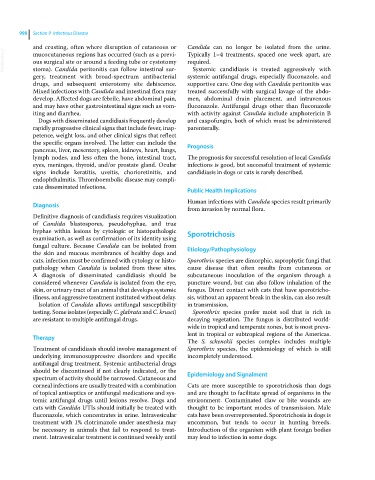Page 1060 - Clinical Small Animal Internal Medicine
P. 1060
998 Section 9 Infectious Disease
and crusting, often where disruption of cutaneous or Candida can no longer be isolated from the urine.
VetBooks.ir mucocutaneous regions has occurred (such as a previ Typically 1–4 treatments, spaced one week apart, are
required.
ous surgical site or around a feeding tube or cystotomy
Systemic candidiasis is treated aggressively with
stoma). Candida peritonitis can follow intestinal sur
gery, treatment with broad‐spectrum antibacterial systemic antifungal drugs, especially fluconazole, and
drugs, and subsequent enterotomy site dehiscence. supportive care. One dog with Candida peritonitis was
Mixed infections with Candida and intestinal flora may treated successfully with surgical lavage of the abdo
develop. Affected dogs are febrile, have abdominal pain, men, abdominal drain placement, and intravenous
and may have other gastrointestinal signs such as vom fluconazole. Antifungal drugs other than fluconazole
iting and diarrhea. with activity against Candida include amphotericin B
Dogs with disseminated candidiasis frequently develop and caspofungin, both of which must be administered
rapidly progressive clinical signs that include fever, inap parenterally.
petence, weight loss, and other clinical signs that reflect
the specific organs involved. The latter can include the Prognosis
pancreas, liver, mesentery, spleen, kidneys, heart, lungs,
lymph nodes, and less often the bone, intestinal tract, The prognosis for successful resolution of local Candida
eyes, meninges, thyroid, and/or prostate gland. Ocular infections is good, but successful treatment of systemic
signs include keratitis, uveitis, chorioretinitis, and candidiasis in dogs or cats is rarely described.
endophthalmitis. Thromboembolic disease may compli
cate disseminated infections.
Public Health Implications
Human infections with Candida species result primarily
Diagnosis
from invasion by normal flora.
Definitive diagnosis of candidiasis requires visualization
of Candida blastospores, pseudohyphae, and true
hyphae within lesions by cytologic or histopathologic Sporotrichosis
examination, as well as confirmation of its identity using
fungal culture. Because Candida can be isolated from Etiology/Pathophysiology
the skin and mucous membranes of healthy dogs and
cats, infection must be confirmed with cytology or histo Sporothrix species are dimorphic, saprophytic fungi that
pathology when Candida is isolated from these sites. cause disease that often results from cutaneous or
A diagnosis of disseminated candidiasis should be subcutaneous inoculation of the organism through a
considered whenever Candida is isolated from the eye, puncture wound, but can also follow inhalation of the
skin, or urinary tract of an animal that develops systemic fungus. Direct contact with cats that have sporotricho
illness, and aggressive treatment instituted without delay. sis, without an apparent break in the skin, can also result
Isolation of Candida allows antifungal susceptibility in transmission.
testing. Some isolates (especially C. glabrata and C. krusei) Sporothrix species prefer moist soil that is rich in
are resistant to multiple antifungal drugs. decaying vegetation. The fungus is distributed world
wide in tropical and temperate zones, but is most preva
lent in tropical or subtropical regions of the Americas.
Therapy
The S. schenckii species complex includes multiple
Treatment of candidiasis should involve management of Sporothrix species, the epidemiology of which is still
underlying immunosuppressive disorders and specific incompletely understood.
antifungal drug treatment. Systemic antibacterial drugs
should be discontinued if not clearly indicated, or the Epidemiology and Signalment
spectrum of activity should be narrowed. Cutaneous and
corneal infections are usually treated with a combination Cats are more susceptible to sporotrichosis than dogs
of topical antiseptics or antifungal medications and sys and are thought to facilitate spread of organisms in the
temic antifungal drugs until lesions resolve. Dogs and environment. Contaminated claw or bite wounds are
cats with Candida UTIs should initially be treated with thought to be important modes of transmission. Male
fluconazole, which concentrates in urine. Intravesicular cats have been overrepresented. Sporotrichosis in dogs is
treatment with 1% clotrimazole under anesthesia may uncommon, but tends to occur in hunting breeds.
be necessary in animals that fail to respond to treat Introduction of the organism with plant foreign bodies
ment. Intravesicular treatment is continued weekly until may lead to infection in some dogs.

